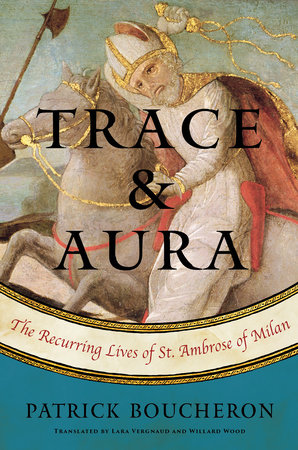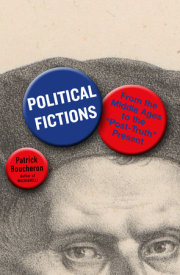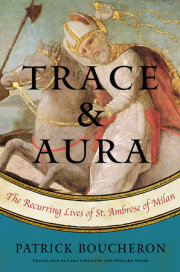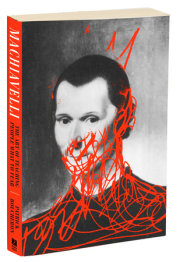PROLOGUEThat Which Returns to the Same Place A child cries out.
In Milan, in 374, a child cries out his name.
Ambrose hears it. He understands where it comes from, this cry that cuts through the crowd, shaking it, establishing it. For from the moment the child cried out
Ambrosius episcopus, the small, unruly flock of Milan’s Christians became a people, his people, and Ambrose their bishop. A few seconds earlier, it was still just a crowd agitated by a thousand quarrels that, “in the greatest of turmoil,” did not know to which religious leader they should turn. It sufficed for a cry to ring out, it sufficed for the child to say the name of this young patrician, Aurelius Ambrosius — Ambrose of the
gens Aurelia, a giant of Rome, born to govern — and suddenly all the Christians of Milan torn between rival factions and opposing faiths “agreed on his name alone in shocking and incredible unanimity.”
But no, he doesn’t want this. They say that on this day in 374, Ambrose slipped away, they say that he resorted to ruses to discourage his followers. He brought prostitutes into his home, he tortured a man under the guise of justice, and, because making blood flow and succumbing to sex wasn’t enough to make it clear that he was rejecting the weight of the ecclesiastical charge being foisted upon him — and since nobody had understood that his first maneuver, his decision “to embrace the profession of philosopher,” was also a provocation — he fled.
For centuries, every detail of this episode of the
Vita Ambrosii written by Ambrose’s secretary and biographer Paulinus of Milan has been painstakingly scrutinized, passionately questioned, and tirelessly commented on. It contains one of the most influential hagiographic themes in political life: a show of renouncing power as the foundation of power. But before coming to this episode in our turn, and since we are on the brink of a book of history, but one that also intends to penetrate into the thickness of time, before leaping in, fully equipped with all the apparatuses that such expeditions of learning demand, let’s paddle for a few more moments in the shallows, skimming the surface of the fiction recounted by Paulinus — here’s what comes next.
Wanting to escape his fate, Ambrose “decided to flee.” One night, in secret, he left the city. He was alone and trying to reach Pavia, called Ticinum in antiquity after the river crossing it, the Ticino. But though he thought he was walking toward his destination, “they found him in the morning at the so-called Roman Gate of the city of Milan . . . For God, who was setting up the bulwark of his Catholic Church . . . prevented his flight.” The people took him in safe custody, waiting for the prefect Probus and the emperor Valentinian, the clement, to confirm the election of the new bishop. Ambrose would not get away.
Is Paulinus of Milan writing an account of a failed escape or is he describing the results of disorientation? Ambrose doesn’t realize that his steps are taking him back to his starting point, undoubtedly because he doesn’t want to believe that every road leads to the
porta Romana, the equivalent of Paris’s
voie triomphale in the imperial capital that was Milan in the fourth century. But all paths converge: Ambrose is unable to leave the city. He is obstinately brought back. By whom? God, of course. So here we have the history of a man who cannot escape the force of his name or the place that force assigns him. Ambrose will be bishop of Milan, Milan will become Ambrose’s city, and the people of Milan, still today, will call themselves Ambrosians.
For nearly fifteen years, I have obsessively explored the history of the memorative gravitation of a name around a city, of a city around a name, murmuring lines from Baudelaire: “I have more memories than if I’d lived a thousand years.” What a strange idea, when you think about it, to take an interest in these old refrains and, more seriously, to pretend they could be of interest to anyone else. Yet here’s the thing: you can think, or dream really, all you want, but we don’t choose the ghosts that haunt us. Menacing or mocking, they remain the faithful companions of our obsessions. And so, here, once again, we will read a ghost story for consenting adults.
Milan was made for this kind of bullheadedness. I chose it nearly thirty years ago precisely because it was a cold city. At the time, it was a question of selecting, heart steeled, a “terrain” for my thesis. At least that’s what I naively believed, thinking it unreasonable to grow overly attached. Except, well, it didn’t work out that way. Perhaps because the gentle spells cast by the Lombard capital, all the more insidious because they remain discreet, always come as a surprise. Alberto Savinio wrote it better than anyone in 1944 in
Ascolto il tuo cuore, città (City, I listen to your heart), noting that the fiercest opponents of Stendhalian pleasure, once in Milan, convert to Stendhalism “with the same ease as one tans at the seaside.”
And so I returned to Milan, carefree, reveling in reunions, somewhat regretting the time lost and the missed opportunities — regretting them, yes, without a doubt, but not all that much — and discovered, moved, that my memories weren’t that stale or faded, but that they regained form in rhythm with my steps. I returned to Milan and gave myself the gift, surreptitiously — feigning the appropriately hesitant manner of a man out for a stroll, with the vague look of a dreamer, eyes half-closed, willingly letting my feet follow ancient tracks, finding those traces I thought I’d forgotten for good — and so, once again, I gave myself the gift of the unexpected and profuse generosity of a city that imperceptibly brought me as close as possible to its heart. For Milan, whose intractable rotundity was already being lauded by Bonvesin da la Riva at the end of the thirteenth century, is one of those enveloping cities that revolves on itself like a wheel around its hub to lead you, no matter what, to its center.
Is this the metaphor represented by the return of Ambrose, incapable of loosening the city’s grip, as if denied all possibility of a narrow escape? It’s more than that. Ambrose can’t get away from Milan for the same reason that we can’t extricate ourselves from the hold of our own names. For what is a proper name, properly speaking, if not the bass line of a rhapsody, its primordial rhythm reminding every individual of the unrelenting invariability of his or her possible futures? A little like
jokari, an old French children’s game: a ball is linked by a string to a small weighted platform; and regardless of the elasticity of the string, and regardless of how hard you hit the ball with your paddle, the twirling foam sphere, whipping the air in complicated spirals, is always drawn back to the center, to the base that anchors it.
But we still need to settle on what Ambrose means to those who, in the Middle Ages, spoke and acted in his name. If, for example, we situate ourselves, as we soon will, in the mid-fifteenth century, Ambrose represents nothing more or less than the memory of a bishop, born in Treves in 339 or 340, who died in Milan in 397, hero of late Roman times, champion of the freedom of the Church, patron saint of the city, and celestial protector of its civic conscience. He is one of those patched-together rememberings through which a society invents a common past, picking out the traces of what remains available. Not every trace: this legacy is, by nature, selective. And so they patiently chose — but who and when, how, why, and under what constraints? That is, as we’ve seen, the point of this project — scraps of the past useful in supporting the invention of a collective identity.
The Ambrosian tradition isn’t the whole of Ambrose, but nor is it a diminished Ambrose, reduced to those parts that serve. I would argue to the contrary that it is a sort of augmented reality, in which the collective memory of Ambrose grows richer and more complex and is clouded by all the other memories that, through resemblance, contiguity, or related ideas, coagulate there — that is to say, before his lifetime, the benevolent cohort of his more or less mythical predecessors, but also and especially after, all those who, among his successors, permitted themselves to use his name to pass for new Ambroses, from the Carolingian bishops of the ninth century to Carlo Borromeo in the sixteenth century. And they are, as a result,
nove sed non nova. They are not the renewed memory of Ambrose but Ambrose himself, acting, again — a phantom in a way, who returned to Milan, like the recalcitrant bishop after his long night walking in circles.
This work of generative rememoration is anything but spontaneous: it results from an at times conscious and often contentious practice by curators of memory that we will need to identify. For the past divides as much as it unites, representing a discursive resource for any collective mobilization. Which is why we can’t solely rely on the notion of civic religion to explore and understand the identification of a political conscience with the patron of the city of Milan, if only because Ambrose, one of the four Latin Doctors of the universal Church, continues to resist any local reduction of a strictly situated memory — and that is undoubtedly also what is prophesized by the fable told by Paulinus of Milan, which is in this sense a political fiction, meaning that it acts as a thought experiment putting the politics to come in written words.
What is one of the most fundamental worries of our day? It resides no doubt in what Jacques Derrida called, back in 1994, the “grave question of the name”: when one starts to act
in the name of a value, allegiance, or religion, and when one no longer recognizes oneself therein, what should be done politically with this thing in the name of which one is acting? We should in no case ever “treat as an accident the force of the name in what happens,” just as we should always take seriously those who claim to speak
in place of another. Here, we are undoubtedly right up against the venomous heart of the task that will busy us in the pages that follow: to dispel the aura of a proper name that envelops the places it beleaguers in a fog so thick as to render their lineaments indistinct, and, by consequence, teach ourselves to no longer be governed by elusive fictions.
What do they call “Ambrosian” in Milan? The particularity of its liturgy or the pride of its clergy? The
libertas demanded by its Church or the civic rights of which its government boasts? All this at once, no doubt, from the moment this distant connection is made a cause of pride. The name Ambrose designates nothing other than this vagueness — a halo of uncertain meaning that creeps in and takes us over. Today still, with two soccer clubs from the Lombard capital playing in Italy’s top league, when Inter’s
nerazzuri face off against AC Milan’s
rossoneri, it suffices for one of the two teams to win for it to become, as the sports journalists write, that of the valiant
ambrosiani.
Everything in Milan is Ambrosian — or more precisely, everything has become so, the result of a slow and jerky history whose outlines we will need to redefine. Again in
Ascolto il tuo cuore, città, Alberto Savinio said it in his way: “Milan shines and reverberates in the glory of its saint . . . But as the brightness of a lamp dissipates in a blinding light, so does the precise image of the saint dissipate in the midst of such glory.” Is it the preciseness of that image that we are chasing here? Perhaps, but we should also clarify the true intentions of the person claiming to lead the hunt. As I was toiling away in an attempt to understand something of the liturgical particularity of the Ambrosian Rite — which I will professorially explain to you in a few hundred pages — I stumbled upon the following remark by one of this subject’s most eminent specialists: only the
studiosi ambrosiani can grasp the deep meaning of these venerable institutions that reach so far into the past, he claims, for, being there in the flesh, it’s only natural that they “breathe the air” of the
mysterium.
Let’s be clear: in order to breathe in this very distinctive air, it is without a doubt not enough, according to our liturgist, to roam the streets of Milan; you have to be familiar with its churches. And here, once again, we’re confronted by the nebulous density of the term
ambrosianità: the
studiosi ambrosiani are not only Milanese, but obviously Catholic as well, and undoubtedly a certain kind of Catholic. It was therefore in the certainty, not in itself particularly blameworthy, of not being Ambrosian that I embarked on this search that is in no way a quest for a personal genealogy, or an attempt to distance myself from any possible attachment to a given place, name, or image, but rather the archaeology of the liturgical foundations of Western government. And so this history will be far from instinctual. I say this thinking of the first page of Fernand Braudel’s
The Identity of France: “For the historian can really be on an equal footing only with the history of his own country; he understands almost instinctively its twists and turns, its complexities, its originalities and its weaknesses.” I don’t deny the existence of instinctual understanding, I simply assert that it isn’t historical. A historian’s work should consist of challenging all that is assumed or accepted as fact, troubling the waters in the way that we might trouble the surface of a mirror by breathing on it. By opting for cold detachment for once, by conceding without fear that we have no affective link to our subject, at the least we are spared from having to battle against all the emotions of belonging. A comfortable choice, no doubt — but it allows us to assess dispassionately the conditions in which were formed, over the long term, in an intermittent, contradictory, and contentious way, collective identities and, perhaps especially, political beliefs.
Copyright © 2022 by Lara Vergnaud and Willard Wood. All rights reserved. No part of this excerpt may be reproduced or reprinted without permission in writing from the publisher.










